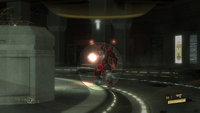Archive:Halo Waypoint/2009 to 2014/Universe/Technology
From Halopedia, the Halo wiki
| The following is a verbatim transcription of an official document for archival reasons. As the original content is transcribed word-for-word, any possible discrepancies and/or errors are included. |
Reach: Implements of War
- Main article: Reach: Implements of War
| “ | Weapons. vehicles and other material utilized during the battle for Reach. | ” |
The UNSC Army has outfitted its soldiers with the best equipment possible, and when that isn't available deep behind enemy lines, they can pry the Covenant's arsenal from the aliens' cold, dead hands.
- Video link: Reach: Implements of War
The Covenant on Reach
- Main article: The Covenant on Reach
| “ | A look at the conglomerate of alien species laying siege to the planet of Reach. | ” |
The Covenant is a broad and expansive empire of races, governed by a singular military goal: the recovery of Forerunner artifacts. Although the arrival of the Covenant at a human planet - and the bloodbath that always followed - has become almost routine to mankind, the aliens' discovery of Reach is both shocking and ominous. Reach, the UNSC's key military stronghold, is the last line of defense against the Covenant's merciless march of destruction towards humanity's homeworld: Earth.
- Video link: The Covenant On Reach
Prototype
| PROTOTYPE | |||
|---|---|---|---|
Under the direction of Vice Admiral Danforth Whitcomb, the Office of Naval Intelligence created a number of classified codename projects during the early-to-mid 26th century, including the more publicly-known SPARTAN-II and MJOLNIR programs. Another such program—known simultaneously as HRUNTING and YGGDRASIL—was a nuclear-powered armor defense system which could be operated by a standard UNSC Marine. Unlike the more compact armor variant of MJOLNIR, HRUNTING/YGGDRASIL’s results would not require extensive and risky biological augmentations for the operator and, as a result, would be much more expensive to design and manufacture. Very few have reported seeing this technology in the field since it remained in a somewhat secretive state well into the war with the Covenant—at least one suit is known to have been deployed in-combat before reportedly being scuppered by ONI as a security precaution. HRUNTING/YGGDRASIL’s mechanical defense systems and weaponry capabilities are expansive—far outstripping MJOLNIR in almost every way save for bio-ergonomic mobility and size. Although its full technical specifications were never made public, reports have indicated the following components were equipped:
Another rumored component was a 300 MT lead-tampered nuclear fission self-destruct sequence (in compliance with Cole Protocol and Winter Contingencies) which would re-use the fusion components of the suit’s power system and begin with a staggered countdown and could only be completed by delivery of a voice command code word—the exact word never having been publicly revealed. This method hints strongly at a kamikaze-style purpose rather than simple security. Since this is illegal under several intact conventions, its official status remains “security.”[1] | |||
Citation:
{{Ref/Site|URL=http://halo.xbox.com/en-US/Universe/detail/prototype/b053d1dc-912b-401b-bb9e-2909d1028c31|Site=Halo Waypoint|Page=Prototype|D=05|M=09|Y=2012|LocalArchive=Archive:Halo Waypoint/2009 to 2014/Universe/Technology#Prototype}} |
VISR
| VISR | |||
|---|---|---|---|
When Project: MJOLNIR launched, ONI was forced to mitigate the substantial losses it incurred during the development and real-world production of its armor technology. Because of MJOLNIR’s embedded fusion reactors, each suit of armor costs significantly more than any other comparative item within the ONI's Special Operations budget—estimated to be somewhere near the cost of a standard warship. For this reason, the UNSC was committed to the widespread application of a variety of individual technologies derived directly from MJOLNIR, specifically for functional use within the military. The Visual Intelligence System Reconnaissance Class, or VISR, is one of these, now used by a wide spectrum of Special Operations personnel. Unlike the variant used by SPARTAN-II super-soldiers, there is no neural interface prerequisite to the VISR. Despite this, it operates in a very similar manner to the heads-up display incorporated into the Mark V and Mark VI suites of MJOLNIR software. At its core, VISR is a standard HUD that offers real-time tactical information about the wearer's health, ammunition count, and mission objectives. In addition to this, VISR can store a considerable amount of data for later review, including custom mission intel, navigational layouts, and audio files to assist the user operating behind enemy lines. The most obvious alteration to the existing MJOLNIR version, however, is the ability to view in low-light mode, highlighting allies, enemies, and points of interest with a brightly lit wire silhouette.[2]
| |||
Citation:
{{Ref/Site|URL=http://halo.xbox.com/en-us/Universe/Detail/visr/46e787cc-207e-4590-9553-51efa66f425d|Site=Halo Waypoint|Page=VISR|D=18|M=05|Y=2012|LocalArchive=Archive:Halo Waypoint/2009 to 2014/Universe/Technology#VISR}} |
Space Tether
| SPACE TETHER | |||
|---|---|---|---|
Over two and a half centuries before the war with the Covenant, humankind began construction on the Earth's first orbital space elevator at the coastal city of New Mombasa. It was the first of six such elevators spread across the planet's surface. The orbital space elevator eventually became a common, affordable means of extra-atmospheric conveyance, allowing the UNSC and private corporate entities the ability to ferry large amounts of material and personnel into space at comparatively low costs. Commonly referred to as "space tethers," the orbital space elevators vary in size and shape, but they are all typically composed of the same raw material. Meshed together as a complex composite of intertwining nano-fibers, these ingredients form a series of massive cords and rings several hundred meters wide. They bind to a grounded set of anchors larger than most buildings which hold the elevator’s structure in place while the Earth spins on its axis. The zenith of the elevator, commonly known as the "orbital" or "terminus," is then pulled taut by the Earth's rotational inertia, sliding into geosynchronous orbit thousands of kilometers above the planet. While Earth has six space elevators, many planets found within the Outer Colonies have more since there is a heavy human reliance on the production and shipment of agricultural and mineral goods from remote worlds. Prior to the Covenant's invasion, the farming colony of Harvest, for example, had seven elevators, while some mineral-rich worlds had as many as nine. Of Earth's six elevators, only four remained intact at the end of the 2552 CE. On October 20, 2552, an incident known as the New Mombasa Slipspace Event severed the city's space elevator, spreading its shattered remnants across East Africa. Only weeks later, a separate event—in Havana, Cuba on November 3, 2552—resulted in the destruction of what was known as the Centennial Orbital Elevator.[3] | |||
Citation:
{{Ref/Site|URL=http://halo.xbox.com/en-us/intel/theuniverse/locations/gallery/space-tether/e9b2f438-9b5b-477e-8e52-d4e6801e9d5b|Site=Halo Waypoint|Page=Space Tether|D=07|M=10|Y=2012|LocalArchive=Archive:Halo Waypoint/2009 to 2014/Universe/Technology#Space Tether}} |
Modular Dispersal Technology
| MODULAR DISPERSAL TECHNOLOGY | |||
|---|---|---|---|
Unlike humanity, whose technological breakthroughs were achieved through exploration and iteration, the Prophets and Elites leveraged found Forerunner artifacts for many of their own advances. Reverse engineering these relics allowed the Covenant to progress in a variety of areas from general materiel technology to extremely precise Slipstream space manipulation. But on occasion, these artificial technical advancements would reveal the Covenant’s misunderstanding and general ignorance of the Forerunners’ intended use of those relics found by the Covenant. One prominent example of this has been catalogued by the UNSC as “MDT” or Modular Dispersal Technology—the large-scale, rapid disassembly of Covenant starships while in a vacuum and, in some situations, during the course of a battle. When vessels were significantly damaged or suffering from atmospheric breaches, rather than immediately return the craft to a shipyard or repair center, the Covenant could simply detach noncritical sections and continue to operate—some ships even retaining the capacity to enter Slipspace. Due to the modular architecture of Covenant ships, a damaged vessel could fully function even after scuttling large portions of its hull and general mass. Upon returning to a refitting station, the ship could then be reconstituted and redeployed with minimal loss. This functionality is easily reconciled with the Covenant’s broader design rationale, in that they commonly prefer the use of redundant, simultaneous components, rather than a centralized system for their ships. Although the Forerunners may have used this technology for this purpose from time to time, it has been determined that the origin of MDT was the Forerunner war with the Flood and that MDT appears to have a different primary purpose for the Forerunners. When the shield and hull of a warship were breached by the implacable parasite, the Forerunners would initiate this measure to disable and scuttle compromised sections of their ships during the battle. The vacuum would then claim whatever Flood remained in the inert portions, providing a somewhat pyrrhic victory against the parasite’s overwhelming dominance. Only a handful of instances have been recorded in which the Covenant have effectively used this technology in naval combat—and even those remained clouded in mystery.[4] | |||
Citation:
{{Ref/Site|URL=http://halo.xbox.com/en-us/intel/related/gallery/modular-dispersal-technology/e10ac7c3-932c-4b3a-91e5-3bf79c179b68|Site=Halo Waypoint|Page=Modular Dispersal Technology|D=14|M=03|Y=2012|LocalArchive=Archive:Halo Waypoint/2009 to 2014/Universe/Technology#Modular Dispersal Technology}} |
Booster Frame
| BOOSTER FRAME | |||
|---|---|---|---|
Open Frame 92 / Extra-Vehicular Activity
Arms:
Defensive Systems:
*The pressurized atmospheric contents of the shells ensure an explosive percussion in a vacuum or other challenging environment. The Booster Frame is a heavily-armed, open-frame incursive vehicle specifically intended for deep space use and close-quarters environments. Its weapon loadout is designed primarily for "Distrupt/Overwhelm/Adapt" - a technique employed to deal with the twin problems of field-effect shielding and armor plating. When used in concert, the combination of EMP, explosive and projectile force can make surgical incisions in large-scale, otherwise impenetrable defenses. There are only two officially recorded missions where the Booster Frame's use has been logged. As evidenced by its open cockpit design, it was developed alongside the MJOLNIR project and in tandem with the research done on EVA technology or "Extra-vehicular Activity" following the Summa Deep Space Incident. It was specifically engineered for use by augmented SPARTAN-II units and is only usefully operable in zero/low-G and zero/low-atmosphere environments. It has no aerodynamic properties beyond its basic mass and thrust quotient. Booster Frames are deployed directly into vacuum through a specialized hydraulic winch system which extends from a ventral bay on a select number of modified UNSC warships and undisclosed ONI special service vehicles. OF92/EVA was developed by the Office of Naval Intelligence in conjunction with Naval Special Operations and the University of Seongnam. As with many ONI projects, both the analysis and eventual materiel response were heavily classified. Because their overall cost clashes with their expendable nature, ONI and the UNSC have no plans for widespread application or production. In fact, it is technically classified by the Naval shipping and logistics organization as Aircraft Ammunition rather than Aircraft.[5] | |||
Citation:
{{Ref/Generic|Id=Waypoint|[[Halo Waypoint]] {{C|[[Xbox 360]] app-only}}|Booster Frame|LocalArchive=Archive:Halo_Waypoint/2009_to_2014/Universe/Technology#Booster Frame}} |
Gauss Technology
| GAUSS TECHNOLOGY | |||
|---|---|---|---|
Though Karl Friedrich Gauss is an unlikely subject of conversation in the corps, every UNSC soldier knows the basic principles of magnetic induction which the scientist pioneered. While complicated in detail, the central values behind such technology are fairly simple. Triggering magnetic energy currents in sequential order can exponentially accelerate an object, hurling it at an impressively violent speed. In scientific jargon, this process is called "asynchronous linear induction." While such technology was used for transportation throughout the 21st century and beyond, only much later were machines such as mass drivers created. Using the same principle, mass drivers could launch payloads from terrestrial locations, ultimately delivering them into space at hyper-sonic speed. It wasn't long after that the military began to explore a more strategic use of this technology, the earliest of such field applications were precursors to the Gauss cannon. And although using a magnetic field to channel high-density objects became an effective measure in terrestrial combat, it was even more potent in space, removed from atmospheric conditions and local gravity. The most common planetside applications of magnetic induction are the UNSC's M12G1 Warthog LAAV and the SP42 Cobra, using M68 and M66 asynchronous linear-induction motors respectively. Magnetic Accelerator Cannons, or MACs, also use this technology. Housed on orbital platforms that surround specific worlds, these massive weapons are organized into battle clusters and provide a planet's first line of defense against outside attack. Other less common, but notable applications include the M99 Stanchion, a sniper rifle that was used during Operation: TREBUCHET, and ONI's prototypic OF92/EVA, or Booster Frame, which was rumored to have been deployed in a handful of highly classified space operations.[6] | |||
Citation:
{{Ref/Site|URL=http://halo.xbox.com/en-us/intel/related/gallery/gauss-technology/71304700-12eb-4ab5-9fe7-a52e4ca4094f|Site=Halo Waypoint|Page=Gauss Technology|D=06|M=10|Y=2011|LocalArchive=Archive:Halo Waypoint/2009 to 2014/Universe/Technology#Gauss Technology}} |
Drop Pod
| DROP POD | |||
|---|---|---|---|
The Single-Occupant Exoatmospheric Insertion Vehicle, or SOEIV, commonly referred to as a drop pod, is a variant of the Human Entry Vehicle, a method of troop deployment from very high altitudes or in many cases from space. Drop pods are most commonly used by Orbital Drop Shock Troopers (ODSTs), although conventional Marines and even Spartans have been known to use them in certain circumstances. The unwieldy rectangular shape is roughly over five meters long from nose to tail, with a bulk span of three meters and a width of similar dimensions. Within a standard SOEIV, an occupant would have access to a crash seat with secured belts, controls for maneuvering the pod, and a variety of communication systems which would allow synchronization with others being deployed during a given drop. Weapon and equipment racks are filled prior to drops and once a successful drop has been achieved, the single hatch is expelled by way of an explosive-gas bolt system triggered by the occupant. Combat drops such as this were historically performed during the wars of the early 20th century by paratroopers who used them to circumvent enemy lines. In the 26th century, the reasons for such deployment has changed very little—although the near ubiquity of meteor and other debris showers in many solar systems adds another strategic component to this type of insertion. ODSTs are typically deployed from high altitude or from an exoatmospheric location, being fired toward the planet's surface until the atmosphere is breached. At this point, the occupant is free-falling at terminal velocity until the pod's automated braking-chute system is initiated, thrusting the pod backward prior to its terrestrial contact—the intended result being a safe landing. Many drops, however, do not end safely. Though these engagements have low overall attrition yields due to the singular occupant nature of the drops, the heightened risk of equipment malfunction or user error make it extremely dangerous. Still, this type of combat infiltration is not uncommon even across different species. During the war with the Covenant, the UNSC observed that Elites were being deployed into combat through similar means, alongside equipment pods and other materiel. Some reports even indicate that the extragalactic parasite known as the Flood used an analogous method of deployment across large spans of localized space, a testament to the overall science and philosophy of such techniques.[7] | |||
Citation:
{{Ref/Site|URL=http://halo.xbox.com/en-us/intel/related/gallery/drop-pod/a37c6831-12e9-4a63-b546-08aeff5bfdc8|Site=Halo Waypoint|Page=Drop Pod|D=25|M=03|Y=2012|LocalArchive=Archive:Halo Waypoint/2009 to 2014/Universe/Technology#Drop Pod}} |
The MJOLNIR Project
- Main article: The MJOLNIR Project
The armor which served to augment and protect the UNSC's last hope for survival.
The MJOLNIR Project 1
It was common knowledge within Section Three of the Office of Naval Intelligence that Doctor Catherine Halsey was working on something critical to the UNSC's war efforts - just what that was remained a mystery for quite some time. When the Spartans' existence was finally revealed, much fanfare was paid to their enhanced combat abilities and reinforced physical bodies. But what might have mattered most was their armor - the one thing which would protect them in the most brutal of combat scenarios.
That armor was called MJOLNIR, and this is its story...
- Video link: The MJOLNIR Project 1
The MJOLNIR Project 2
In August of 2552, nearly all surviving SPARTAN-II super-soldiers returned to the planet Reach to be briefed on a top-secret mission. When they arrived, they were equipped with the MJOLNIR Mark V armor - a specialized upgrade to the existing armor that had been serving them well for decades.
Mark V, however, was only the tip of the iceberg. For years, the UNSC and ONI had already been crafting a large number of variations on this armor - all of them customized toward specific attributes and functions on varied battlefields. These steps would play a crucial role in the battles to come, creating specialized classes and teams designed for specific purposes.
While many Spartans perished during the fall of Reach, MJOLNIR had been historically viewed as a technological success. Even with those who remain skeptical of the individual Spartan programs have admitted that without the effective military application of MJOLNIR, the human species would have likely been brought to extinction.
- Video link: The MJOLNIR Project 2
Sources
- ^ Halo Waypoint, Prototype (Retrieved on Sep 5, 2012) [local archive] [external archive]
- ^ Halo Waypoint, VISR (Retrieved on May 18, 2012) [local archive] [external archive]
- ^ Halo Waypoint, Space Tether (Retrieved on Oct 7, 2012) [local archive] [external archive]
- ^ Halo Waypoint, Modular Dispersal Technology (Retrieved on Mar 14, 2012) [local archive] [external archive]
- ^ Halo Waypoint (Xbox 360 app-only), Booster Frame [archive]
- ^ Halo Waypoint, Gauss Technology (Retrieved on Oct 6, 2011) [local archive] [external archive]
- ^ Halo Waypoint, Drop Pod (Retrieved on Mar 25, 2012) [local archive] [external archive]











































